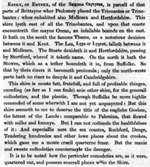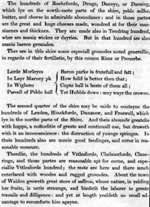
|
Extracts from Norden's Description of Essex, 1594 This written Description was part of John Norden's Survey of Essex, [see item 9 above.] This survey unlike his surveys of Hertfordshire and Middlessex was not published at the time. It is drawn from the original manuscript in the library at Hatfield House and was edited by Sir Henry Ellis for the Camden Series in 1840. . If the language is rather fulsome and the Biblical reference to an 'English Goshen', i.e. to the land of milk and honey, does not seem to square with our perception of reality in Essex , then it is to be remembered that surveyors and map-makers like Norden depended upon their patrons for a living. It would not do to make too much of the 'dangers' of a county. The 'most cruel quarterne fever' found in the low places about the creeks' was no exaggeration. Known also as 'marsh fever' and 'marsh ague' it was a serious killer on occasions and has been identified in modern times with a form of malaria .The parasite Plasmodium vivax was carried by the atroparvus mosquito, which still breed in Essex coastal marshes, and this parasite can tolerate cooler climates than the more virulent Plasmodum falciparum carried by the more infamous anopheles mosquito. Few people realise that malaria, (literally 'bad air'), was once indigenous along English shores.70 Daniel Defoe in a later age was to make something of the problem in this 'damp part of the world'.71 Defoe later recorded a 'strange decay of women here; insomuch that all along this county it was very frequent to meet with men that had from five to six to fourteen or fifteen wives' - women apparently having a physiological disposition to suffer more from this disease of the blood. During World War I soldiers convalescing in the north Kent marshes reinfected the local English mosquitoes with vivax malaria and there was an epidemic of almost 500 cases. Photographs survive of squads of soldiers armed with wooden rakes marchng off on anti-malaria expeditions near Sandwich in Kent.
|
||||||||
 |

